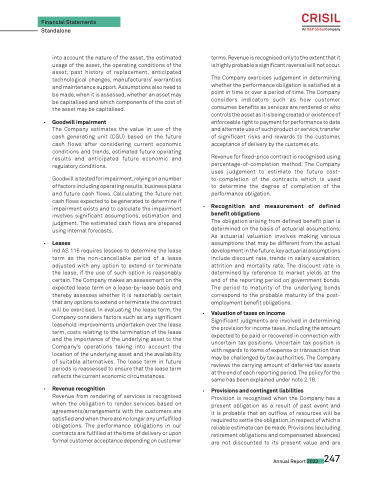Page 249 - Crisil Annual Report 2023
P. 249
Financial Statements
Standalone
into account the nature of the asset, the estimated usage of the asset, the operating conditions of the asset, past history of replacement, anticipated technological changes, manufacturers’ warranties and maintenance support. Assumptions also need to be made, when it is assessed, whether an asset may be capitalised and which components of the cost of the asset may be capitalised.
• Goodwill impairment
The Company estimates the value in use of the cash generating unit (CGU) based on the future cash flows after considering current economic conditions and trends, estimated future operating results and anticipated future economic and regulatory conditions.
Goodwill is tested for impairment, relying on a number of factors including operating results, business plans and future cash flows. Calculating the future net cash flows expected to be generated to determine if impairment exists and to calculate the impairment involves significant assumptions, estimation and judgment. The estimated cash flows are prepared using internal forecasts.
• Leases
Ind AS 116 requires lessees to determine the lease term as the non-cancellable period of a lease adjusted with any option to extend or terminate the lease, if the use of such option is reasonably certain. The Company makes an assessment on the expected lease term on a lease-by-lease basis and thereby assesses whether it is reasonably certain that any options to extend or terminate the contract will be exercised. In evaluating the lease term, the Company considers factors such as any significant leasehold improvements undertaken over the lease term, costs relating to the termination of the lease and the importance of the underlying asset to the Company’s operations taking into account the location of the underlying asset and the availability of suitable alternatives. The lease term in future periods is reassessed to ensure that the lease term reflects the current economic circumstances.
• Revenue recognition
Revenue from rendering of services is recognised when the obligation to render services based on agreements/arrangements with the customers are satisfied and when there are no longer any unfulfilled obligations. The performance obligations in our contracts are fulfilled at the time of delivery or upon formal customer acceptance depending on customer
•
terms. Revenue is recognised only to the extent that it is highly probable a significant reversal will not occur.
The Company exercises judgement in determining whether the performance obligation is satisfied at a point in time or over a period of time. The Company considers indicators such as how customer consumes benefits as services are rendered or who controls the asset as it is being created or existence of enforceable right to payment for performance to date and alternate use of such product or service, transfer of significant risks and rewards to the customer, acceptance of delivery by the customer, etc.
Revenue for fixed-price contract is recognised using percentage-of-completion method. The Company uses judgement to estimate the future cost- to-completion of the contracts which is used to determine the degree of completion of the performance obligation.
Recognition and measurement of defined benefit obligations
The obligation arising from defined benefit plan is determined on the basis of actuarial assumptions. As actuarial valuation involves making various assumptions that may be different from the actual development in the future, key actuarial assumptions include discount rate, trends in salary escalation, attrition and mortality rate. The discount rate is determined by reference to market yields at the end of the reporting period on government bonds. The period to maturity of the underlying bonds correspond to the probable maturity of the post- employment benefit obligations.
Valuation of taxes on income
Significant judgments are involved in determining the provision for income taxes, including the amount expected to be paid or recovered in connection with uncertain tax positions. Uncertain tax position is with regards to items of expense or transaction that may be challenged by tax authorities. The Company reviews the carrying amount of deferred tax assets at the end of each reporting period. The policy for the same has been explained under note 2.18.
Provisions and contingent liabilities
Provision is recognised when the Company has a present obligation as a result of past event and it is probable that an outflow of resources will be required to settle the obligation, in respect of which a reliable estimate can be made. Provisions (excluding retirement obligations and compensated absences) are not discounted to its present value and are
•
•
Annual Report 2023 247


